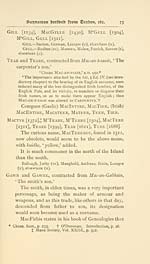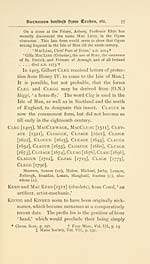Download files
Complete book:
Individual page:
Thumbnail gallery: Grid view | List view

76 Manx SiwtnamEa.
the Mac-an-GhobhAxM were historians to the
O'Kennedys of Ormond.
' Maelbrighde Mac-an-Ghobhann,' a.d. 1061*
Henry Gawen was * Atturney ' in 1517.
Compare (Irish) M^Gowan, Gowan, Gavan,
(Gaehc) M^Gavin, (Enghsh) Smithson.
MacGawne+ [1422], M'Gawen, M'Gawn [1430],
Gawen [1517], Gawne [1586], Gawn [1599], Gown
[1601].
Malew, Rushen (vc), Jurby, Ballaugh, Arbory (c), else-
where (u).
MacCray [1511], Cry [i6it], Crye [1623], is possibly
from MacCraith, ' The weaver's son.' In Ireland
and Scotland this name is now found in the form
Macrae.
Nideragh [1611], Nidraugh and Nedraugh [1623]
(extinct), has possibly some connection with the
Manx word fidderagh, ' weaving.'
Clague and Cleg, contracted from MacLiaigh, ' The
leech's son ' {Liagh, ' leech ').
' In the T'ai'n B'a Ciiailng;e^ a Fdth-Laig, or Prophet-
Leech, heals the wounds of Cuchiilaind^ after his fight with
Ferdiad. It is probable, therefore, that in Pagan times the
Liag (leech) belonged to the order which may be conven-
tionally called Druidic, and that charms and incantations
formed part of the means of cure. The position assigned to
the Leech by the laws in the middle ages was a very high
one. He ranked with the smith and the Cerd, or artist in
gold and silver ; and the Ollamh, or doctor in leech-craft,
ranked with an Aire Ard, z>., one of the highest grades of
lord. He had also a distinguished place at assemblies, and
at the table of the king. Leech-craft became hereditary in
certain families, some of whose names indicate their profes-
sion, as O'Lee, /.,?., O'LiAiGH.'J
* Four Mast., Vol. 1 1., p. 881. fin the British Museum copy only.
X Ency. Brit. art. on Celtic Literature.
the Mac-an-GhobhAxM were historians to the
O'Kennedys of Ormond.
' Maelbrighde Mac-an-Ghobhann,' a.d. 1061*
Henry Gawen was * Atturney ' in 1517.
Compare (Irish) M^Gowan, Gowan, Gavan,
(Gaehc) M^Gavin, (Enghsh) Smithson.
MacGawne+ [1422], M'Gawen, M'Gawn [1430],
Gawen [1517], Gawne [1586], Gawn [1599], Gown
[1601].
Malew, Rushen (vc), Jurby, Ballaugh, Arbory (c), else-
where (u).
MacCray [1511], Cry [i6it], Crye [1623], is possibly
from MacCraith, ' The weaver's son.' In Ireland
and Scotland this name is now found in the form
Macrae.
Nideragh [1611], Nidraugh and Nedraugh [1623]
(extinct), has possibly some connection with the
Manx word fidderagh, ' weaving.'
Clague and Cleg, contracted from MacLiaigh, ' The
leech's son ' {Liagh, ' leech ').
' In the T'ai'n B'a Ciiailng;e^ a Fdth-Laig, or Prophet-
Leech, heals the wounds of Cuchiilaind^ after his fight with
Ferdiad. It is probable, therefore, that in Pagan times the
Liag (leech) belonged to the order which may be conven-
tionally called Druidic, and that charms and incantations
formed part of the means of cure. The position assigned to
the Leech by the laws in the middle ages was a very high
one. He ranked with the smith and the Cerd, or artist in
gold and silver ; and the Ollamh, or doctor in leech-craft,
ranked with an Aire Ard, z>., one of the highest grades of
lord. He had also a distinguished place at assemblies, and
at the table of the king. Leech-craft became hereditary in
certain families, some of whose names indicate their profes-
sion, as O'Lee, /.,?., O'LiAiGH.'J
* Four Mast., Vol. 1 1., p. 881. fin the British Museum copy only.
X Ency. Brit. art. on Celtic Literature.
Set display mode to: Large image | Transcription
Images and transcriptions on this page, including medium image downloads, may be used under the Creative Commons Attribution 4.0 International Licence unless otherwise stated. ![]()
| Early Gaelic Book Collections > Blair Collection > Surnames & place-names of the Isle of Man > (94) |
|---|
| Permanent URL | https://digital.nls.uk/82100776 |
|---|
| Description | A selection of books from a collection of more than 500 titles, mostly on religious and literary topics. Also includes some material dealing with other Celtic languages and societies. Collection created towards the end of the 19th century by Lady Evelyn Stewart Murray. |
|---|
| Description | Selected items from five 'Special and Named Printed Collections'. Includes books in Gaelic and other Celtic languages, works about the Gaels, their languages, literature, culture and history. |
|---|

